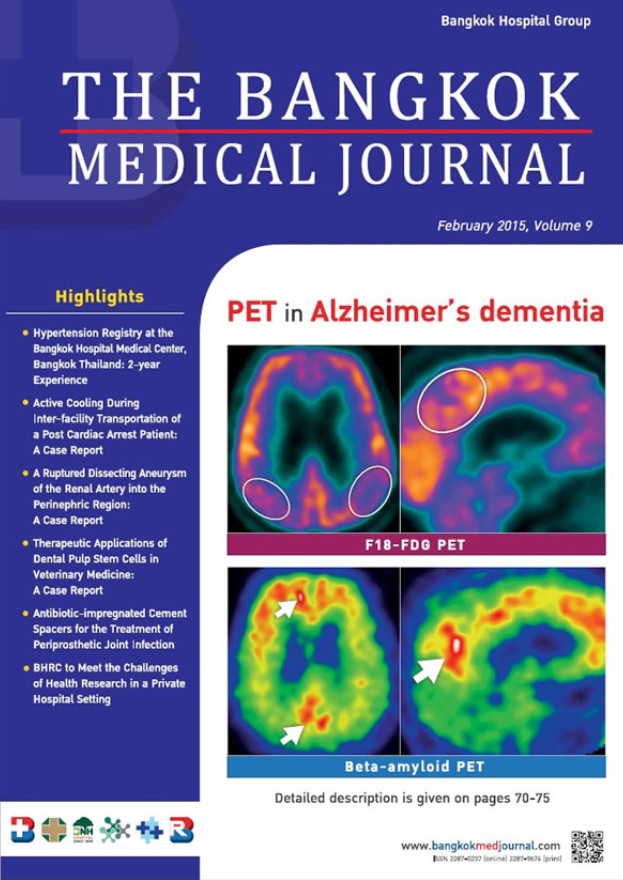The Coumadin Ridge: Why Do We Need To Know About It?
Main Article Content
Abstract
Coumadin or Warfarin ridge is so named for its band-like structure that originates in the left atrium and is almost always misdiagnosed as a cardiac tumor or a cardiac thrombus. This article will detail the important information of the coumadin ridge and demonstrate its structure and location with the use of Magnetic Resonance Imaging (MRI) .
Article Details
How to Cite
1.
Chaothawee L. The Coumadin Ridge: Why Do We Need To Know About It?. BKK Med J [internet]. 2015 Feb. 20 [cited 2025 Dec. 28];9(1):83. available from: https://he02.tci-thaijo.org/index.php/bkkmedj/article/view/221105
Issue
Section
Medical Images
This is an open access article distributed under the terms of the Creative Commons Attribution Licence, which permits unrestricted use, distribution, and reproduction in any medium, provided the original work is properly cited.
References
1. Broderick LS, Brooks GN, Kuhiman JE. Anatomic pitfalls of the heart and pericardium. Radiographics 2005;25:441-53
2. Ho SY, McCarty KP, Faletra FF. Anatomy of the left atrium in interventional echocardiography. Eur J Echo- cardiogr 2011;12:i11-5.
3. Cabrera JA, Ho SY, Climent V, et al .The architecture of the left lateral atrial wall: a particular anatomic region with implications for ablation of atrial fibrillation. Eur Heart J 2008;29:356–362
4. Click RL, Cai JX, Martin AD. Perioperative transeso- phageal echocardiography: Self-assessment and review. Philadelphia: Lippincott Williams&Wilkins, 2008.
5. Hwang C, Wu TJ, Doshi RN , et.al. Vein of Marshall cannulation for the analysis of electrical activity in patients with focal atrial fibrillation. Circulation 2000; 101:1503-5.
6. Kistler PM, Early MJ, Harris S, et al. Validation of three dimensional cardiac image integration; Use of integrated CT image into electroanatomic mapping system to perform catheter ablation of atrial fibrillation. J Cardiovasc Electrophysiol 2006;17:341-8.
7. Armstrong WF, Ryan T. Feigenbaum’s Echocardiography. 7th ed. Philadelphia, PA:Lippincott Williams and Wilkins, 2009.
8. Grebenc ML, Rosado de christenson ML, Burke AP, et al. Primary cardiac and pericardial neoplasms: radiologic- pathologic correlation. Radiographics 2000;20:1073-103.
9. Mckay T, Thomas L. Coumadin ridge in the left atrium on three dimensional transthoracic echocardiography. Eur J echocardiography 2008;9:298-300.
2. Ho SY, McCarty KP, Faletra FF. Anatomy of the left atrium in interventional echocardiography. Eur J Echo- cardiogr 2011;12:i11-5.
3. Cabrera JA, Ho SY, Climent V, et al .The architecture of the left lateral atrial wall: a particular anatomic region with implications for ablation of atrial fibrillation. Eur Heart J 2008;29:356–362
4. Click RL, Cai JX, Martin AD. Perioperative transeso- phageal echocardiography: Self-assessment and review. Philadelphia: Lippincott Williams&Wilkins, 2008.
5. Hwang C, Wu TJ, Doshi RN , et.al. Vein of Marshall cannulation for the analysis of electrical activity in patients with focal atrial fibrillation. Circulation 2000; 101:1503-5.
6. Kistler PM, Early MJ, Harris S, et al. Validation of three dimensional cardiac image integration; Use of integrated CT image into electroanatomic mapping system to perform catheter ablation of atrial fibrillation. J Cardiovasc Electrophysiol 2006;17:341-8.
7. Armstrong WF, Ryan T. Feigenbaum’s Echocardiography. 7th ed. Philadelphia, PA:Lippincott Williams and Wilkins, 2009.
8. Grebenc ML, Rosado de christenson ML, Burke AP, et al. Primary cardiac and pericardial neoplasms: radiologic- pathologic correlation. Radiographics 2000;20:1073-103.
9. Mckay T, Thomas L. Coumadin ridge in the left atrium on three dimensional transthoracic echocardiography. Eur J echocardiography 2008;9:298-300.


